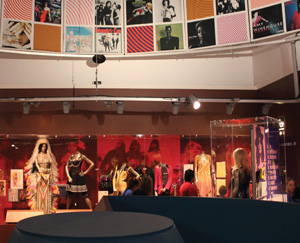by Grace Austin
Tina Turner, Janis Joplin, Bessie Smith, Madonna, and Chrissie Hynde. What do these women have in common? They were all innovators of music in their respective genres and times, and they were all women.
The Rock and Roll Hall of Fame, located in Cleveland, Ohio, is wrapping up its nine-month long exhibit Feb. 26 entitled, “Women Who Rock: Vision, Passion, Power.” Showcasing women’s role in rock music, as well as popular music and popular culture, the exhibit highlights influential female artists, some famous and some not, over a ninety-year span.
“This exhibit is not just a women’s story, it’s a human story. I’m so happy people are responding in a [good] way. People are really seeing the humanity,” said Rutledge.”
The exhibit is a sprawling, colorful odyssey spanning three floors, beginning with Lady Gaga’s simple childhood piano adorned with family and childhood photos of the star. Walk up a level and you are transported into dark rooms filled with audio and video tributes, memorabilia, and fantastic costumes and dresses, including Cher’s “Half-Breed” dress, Grace Slick’s Woodstock garb, and Lady Gaga’s ode to beef jerky, the infamous “meat dress.”
With a lifesize portrait of Joan Jett welcoming visitors into the exhibit, the “foremothers” of rock begin the tour. These women, like Ma Raney and Billie Holiday, combined divergent styles of R&B, gospel, and country to create what is now known as rock ’n’ roll.
The exhibit pushes on, traipsing through another full floor and eight eras of music and memorabilia. Milestones in women’s, American, and world history are displayed, as well as brief biographies and career overviews of the women rockers.
The exhibit also highlights female songwriters behind the scenes of the famous acts, like Carole King and Ellie Greenwich.
Some of the famed acts are supplemented by less well-known but equally talented acts, including Goldie and the Gingerbreads, the first all-female group to play their own instruments to be signed to a major record label.
For all the milestones through the decades, many women in music felt tremendous odds in a male-dominated industry, as Meredith Rutledge, Assistant Curator, can attest to.
“Women were outsiders in the music industry. Rock music, especially, has been a boy’s club from the beginning. Women were seen as novelties, the chick singer on the side. Women who had strong ideas about being taken seriously were seen as threatening to the male establishment,” said Rutledge.
Up to the 1980s, many radio stations’ corporate offices set an informal limit of records by female artists per hour. Other mucisians, like Loretta Lynn, felt the corporation’s male-dominated, traditionalist sway on their music.
“Loretta Lynn’s song “The Pill” is a pretty straightforward song about a rural woman who has discovered freedom from washing diapers and filling bottles all the time because she found birth control. At the time the record company wouldn’t touch it because it was too hot, [releasing it two years after its recording]. Doctors would [approach] Loretta Lynn after her performances and thank her for that record because they had been trying to promote family planning,” said Rutledge. “She really opened up a dialogue. For a pop record to have that much power is really incredible.”

Inspired by hard-rocking Led Zeppelin, bands like Heart in the early ‘70s portrayed an edgier female image than the singer-songwriters of the time.
“They showed you didn’t have to stand behind an accoustic piano or guitar and sing sweet folk songs,” said Rutledge. “You could be a rocker.”
Later on, the punk and post-punk era gave women another avenue for expression.
“Women could be what they want to be. Punk rock was a perfect vehicle for a woman because women are outsiders in the music industry to begin with. Punk’s all about sticking it to the establishment and thwarting the given order,” said Rutledge.
To this day, there is a significant disparity in the music industry, specficially in the top positions and background.
“Behind the scenes, on the business end, as producers, women executives, women are still finding there’s a glass ceiling,” said Rutledge.
Through this exhibit, Rutledge hopes not only to impart a message of female empowerment, but also one of inclusion.
“This exhibit is not just a women’s story, it’s a human story. I’m so happy people are responding in a [good] way. People are really seeing the humanity,” said Rutledge.
This article has been sponsored by:
Linkage’s Institute for Leading Diveristy & Inclusion






